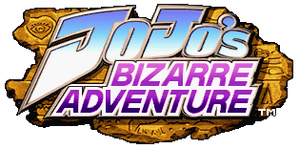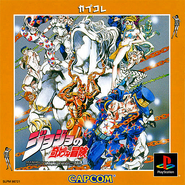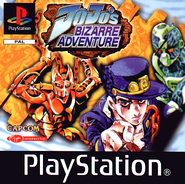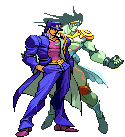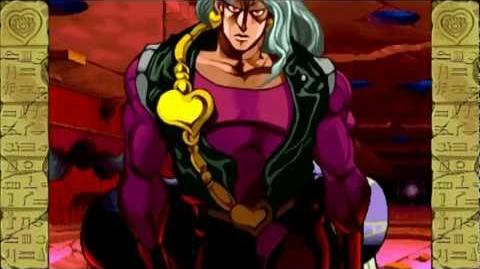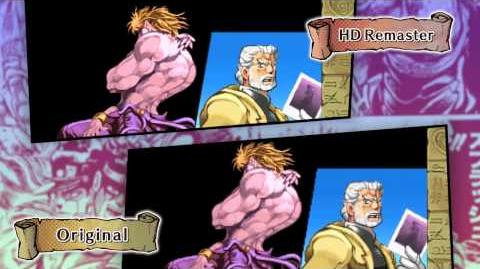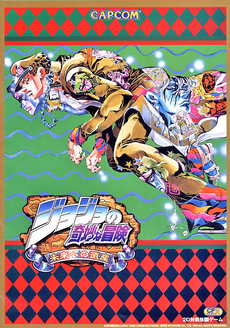
Heritage for the Future arcade flyer.
JoJo's Bizarre Adventure (ジョジョの奇妙な冒険, Jojo no Kimyō na Bōken) is a 1999 fighting game developed by Capcom based on author Hirohiko Araki's famous manga series of the same name. The story takes place during the third story arc of the comics, Stardust Crusaders.
It was originally released in the arcade in 1998 on the CPS-3 arcade system; this version was known outside of Japan as JoJo's Venture. An updated version of the game was released in 1999 as JoJo's Bizarre Adventure: Heritage for the Future (ジョジョの奇妙な冒険 未来への遺産 JoJo no Kimyō na Bōken Mirai e no Isan), becoming the sixth and last game released for the CPS-3 board (the second-to-last being the third revision of Street Fighter III: Street Fighter III 3rd Strike, released only a few months earlier). Console ports for the Playstation and Dreamcast were also released that year (minus the subtitle).
The game was originally obscure in the West (since the manga and anime series were also obscure at the time and it was also considered too weird for most of the masses), but because of the rise of the JoJo's Bizarre Adventure franchise's popularity (the new anime, the official manga release by VIZ Media and All Star Battle are some contriubing factors), it's popularity has raised as well.
The Dreamcast version is an "2 in 1 package", featuring both the original and revised versions of the arcade game in their original forms. The PlayStation version is based on JoJo's Venture, but features some of the additional characters from the Heritage update and an exclusive "Super Story Mode" that adapts the entirety of part 3. Although there are a few unnoticeable frames missing from the PlayStation port and the sprites have less detail (specially the Stands).
A high-definition version of the game was released on PlayStation Network and Xbox Live Arcade in August 2012, before being removed from both platforms in September 2014.
Characters
| Playable Fighters (JoJo's Venture) | Stand | Info |
|---|---|---|
| Jotaro Kujo | Star Platinum | When Joseph Joestar's grandson first appears, Jotaro is turning himself in to the police because he believes his Stand is an evil spirit possessing him. Joseph comes to Jotaro's aid with Mohammed Avdol. A brief fight ensues, getting Avdol involved. After Jotaro is released from jail and learns more about his Stand, he discovers that the evil vampire Dio Brando must be destroyed, or his mother will die. |
| Joseph Joestar | Hermit Purple | His stand manifests itself as a tangle of thorny vines, which Joseph can wield as both weapon and defense. They are relatively weak; however, Hermit Purple also provides Joseph with considerable telepathic ability. |
| Young Joseph/JoJo (Bonus Character) | None | The version of Joseph is from the second story arc, "Battle Tendency". He does not have a Stand, and instead uses his Hamon-based powers. In the Japanese version, he is called 誇り系統ジョセフ (lit. proud lineage Joseph) referencing the original subtitle of part 2; "Joseph Joestar: His Proud Lineage" (ジョジョの奇妙な冒険 第二部 ジョセフ・ジョースター ―その誇り高き血統 JoJo no Kimyō na Bōken Dai Ni Bu Josefu Jōsutā Sono Hokoritakaki Kettō). |
| Muhammed Avdol | Magician's Red | Iggy's owner and tamer, Avdol helped awaken Jotaro's own powers. He was first felled by Hol Horse (and revived due to fan demand). He is eventually vaporized by Vanilla ice. |
| Noriaki Kakyoin | Hierophant Green | The pink-haired student was initially brainwashed by Dio into attempting to kill Jotaro. After being freed, he joins the heroes in their fight against the vampire. During the fight with N'doul he was slashed across the eyes and put out of commission for a while. |
| Jean Pierre Polnareff | Silver Chariot | Like Kakyoin, a former enemy turned ally, who fell under Dio's influence twice, disposing the most amount of enemies alongside the Joestars. He would survive the adventure and find himself working with Dio's son for a righteous cause, albeit in a reduced capacity. Polnareff was the biggest inspiration towards the character design of SNK's The King Of Fighters character Benimaru Nikaido. |
| Iggy | The Fool | A little Boston Terrier possessing the power to control sand. While trying to defend Polnareff, he is decimated by Vanilla ice. In the Japanese version, Iggy can talk. |
| Alessi | Sethan | His Stand has the ability to transform anyone who steps on the Stand's shadow to become younger the longer they stand on it, even to the point of becoming a fetus. |
| Devo the Cursed | Ebony Devil | A Native American shaman who works as an assassin for hire, using the Ebony Devil doll to do the dirty work. |
| Chaka | Anubis | His Stand is a sword that possesses its wielder, and remembers all attacks it encounters. |
| Midler | High Priestess | Her Stand can take the form of anything, utilizing the metals and minerals around it. She was not properly show in the manga storyline so Capcom asked Araki to redesign her into something like a belly dancer. Since it was make by the original author and was used in the JOJO A-GO!GO! artbook, the Heritage for the Future design is her new canon look (however, in the part 3 anime, Midler's manga design was used instead of her Heritage for the Future design). |
| Vanilla Ice | Cream | Dio's most loyal henchman. His Stand Cream can create a dimensional void. If any part of an object touches the sphere, that part is irrevocably gone, sucked into the void and vaporized. After proving his loyalty to Dio by cutting off his own head, Dio resurrects him as a vampire. |
| Dio Brando | The World | The main antagonist, who became a vampire through the Stone Mask artifact. He wields The World, a Stand that can stop time. At the bottom of the sea, Dio's severed head reattached itself to Jonathan Joestar's lifeless body (giving DIO the same star birthmark as the members of the Joestar family). After he returns to land, he develops a Stand, giving him vastly powerful new abilities on top of his vampiric powers, in addition to an inherent connection with the Joestar family. Jonathan's grandson Joseph soon learns of his return. He is survived by some of his women that he impregnated, and children, among them Giorno Giovanna, who would later become a protagonist of a JoJo series arc himself. |
| Shadow Dio |
The world (Undeveloped) |
Based on Dio when he is seen bathed in the shadows of his mansion, the version of him can be quite powerful. |
| Playable Fighters Added or Introduced in JoJo's Bizarre Adventure | Stand | Info |
|---|---|---|
| Hol Horse | The Emperor and The Hanged man | An arrogant cowboy and the wielder of the Emperor Stand, which takes the form of a revolver. Upon being fired, the Emperor can control the bullet's flight path, allowing it to turn in midair. At first, his ally was J. Geil, who killed Polnareff's sister, Sherry. Geil was killed by Polnareff in vengeance-motivated attack. |
| Mariah | Bast | Her Stand inflicts an increasingly powerful magnetic charge upon the victim. She was outsmarted by Joseph and Avdol, leading to her defeat. |
| Petshop | Horus | He is a large falcon with the sole job of guarding Dio's mansion. He serves as Iggy's main adversary. |
| Black Polnareff | Silver Chariot + Anubis | Polnareff touching the Anubis sword after defeating Chaka resulted into this character. Like Chaka, he is able to remember attack patterns and use them to his advantage. Again, Jotaro saved him from the enslavery, the first time being from Dio's own cells infesting his head. In the Japanese version, he is called アヌビス二刀流ポルナレフ (lit.Anubis dual wield Polnareff). |
| Rubber Soul (Bonus Character) | Yellow Temperance | Another assassin for hire who uses his Stand to disguise himself as Kakyoin. His stand can take the appearance of anything Rubber Soul wants, no matter what. It also has the capacity to absorb obscene amounts of physical punishment and assimilate other flesh, using it to grow stronger and larger. It cannot however, make up for human frailties, such as the need for oxygen. Jotaro discover this and used it to defeat him. |
| Khan (Bonus Character) | Anubis | Though not his Stand's original user, Anubis possesses him upon contact. A barber who unsheathed the Anubis sword out of curiosity, resulting into a menacing foe that Jotaro later defeated. |
| Hol horse and Boingo (Bonus Character) | The Emperor and Thoth | After Geil's death and earning Enya Geil's wrath for it, his devotion to DIO was renewed after an incident in the Egypt mansion that demonstrated Dio's true powers. To confront the Joestar party again, he teams up with Boingo, who is out to avenge his brother Oingo after he was injured by Polnareff. |
| New kakyoin (Bonus Character) | Hierophant Green | Kakyioin after recovering from the N'doul fight.He fights much the same as Kakyoin, but the range on most of his attacks is greatly reduced, and he takes more damage, he also has sunglasses and his uniform is light green to further distance him from the original version. In the Japanese version he is called 恐怖を乗り越えた花京院 (lit. "Kakyoin who overcame his fears") referencing his character evolution. |
Gameplay
The game combines Capcom's trademark anime-inspired graphics, as seen in the Darkstalkers series, with the colorful characters and events of Hirohiko Araki's creation, resulting in a highly stylized and detailed visual style. It also features many of the gameplay mechanics seen on previous Capcom fighting games, such as the use of power gauges for super moves, as well as a brand new Stand Mode. In the game's storyline (based on the third story arc of the manga), a Stand is a manifestation of the psyche, or a spirit, that accompanies each character and can be summoned or dismissed at will by the player, resulting in variations on the character's move list and abilities. Despite their power, Stands hold one drawback; any damage received by the Stand is transmitted to its user.
Hirohiko Araki served as a consultant for the game and created exclusive pieces of artwork for its promotion and packaging; most notably, he developed from scratch a new character design for Midler, since Capcom was interested in using her in the game and she had been only vaguely shown in the original manga.
Stand Mode
Fighting with the "Stand Mode" on enhances both the character's offensive and defensive abilities; these improvements heavily depend of the character and Stand, but some common ones are for example double jumping, absorbing residual damage when blocking special attacks, powered-up special moves, etc.
Most of the game's specific mechanics derive from the introduced Stand Mode. For example, attacking the physical manifestation of the enemy's stand will cause damage on both of them; this is a crucial strategic element, since many of the special moves and attacks send the Stand away from the user, adding the difficulty of protecting both of them at the same time. On top of the usual health bar and power gauge, there is a third meter, the "Stand Gauge", which decreases when the Stand is damaged and refills when the Stand Mode is switched off; if this gauge is depleted, a "Stand Break" is caused, and the character is paralyzed and wide open to any attack for an instant.
Other features of the Stand Mode include summoning the Stand with an instant attack, the possibility of "programming" attack patterns on the fly and unleashing them at will, "releasing" the Stand and controlling it directly, and so forth.
Some characters lack an "active" Stand, though; some of these "passive" Stand users introduce even more complex and specific mechanics into the game, such as Hol Horse's gun-Stand or Mariah's magnetic Stand.
The Stands create strong differences between the characters, and force often radically different offensive approaches for each one; this "character-dependent gameplay" style would be present in posterior fighting games, such as the latter entries of the Guilty Gear series, which, interestingly enough, also includes many Rock and pop music references as well.
Bonus Stages and Special Battles
Across the game and if certain conditions are met, the player will have to clear special stages and face secret opponents in which special rules apply and which reenact certain chapters of the manga that were less "translatable" as regular combats. Among these special events a sidescrolling sequence in which the player has to overcome a Geb and find its user N'Doul, a special battle against Death 13 or find Arabia Fats to defuse his stand,The Sun, before time runs out.
They also include other special matches as well, but those were exclusive for the PlayStation version via the Super Story mode such as Gray Fly, Enya Geil, Captain Tennille Imposter: (in an interactive movie), Forever (in an interactive action sequence), Nena (interactive movie scene), ZZ (interactive movie scene), Steely Dan (side scrolling shooter), Cameo,Daniel J.D'arby (interactive mini game), Telence T.D'arby (interactive movie scene) and Kenny G (interactive mini game).
Secret Factors
A interesting feature of the Super Story mode is the activation of secret factors. As the game itself is really faithful to the original manga series, playing out the scenario akin to official canon will activate these factors, if the player do it right, it gives them a high ranking upon winning the scenario, and is a unique feature that also celebrates its source material and rewards fans and readers of the series.
This feature appaeared again in Le Bizzarre Avventure di GioGio: Vento Aureo which is also a game based on the JoJo's Bizarre Adventure license and a Capcom product.
Blazing Fists Match
One of the less known features of the game, but also one of the most impressive, it's caused when two certain opposing special moves are performed by certain characters at the very same time collide; the player/s are then prompted to quickly bash the attack buttons to win a "Blazing Fists" duel and decide who will receive the damage, a feature first seen in Samurai Shodown.
Alessi Mode
When Alessi uses Sethan to de-age the characters some of them turn into minor characters instead of their child forms. In the Dreamcast version there's Alessi Mode, which allows these de-aged characters to be played in a set of rules (both players fighting as the kid counterparts for the whole round or the characters turning into children during a Stand crash). This mode is unlocked by finishing Challenge mode with Alessi.
- Kid forms (Jotaro, Kakyoin, Avdol, Polnareff, Devo, Middler, Pet shop, Vanilla Ice, Alessi)
- Young Joseph (Joseph)
- Teenage Joseph (Young Joseph)
- Iggy's older design (Iggy)
- Disguised Fat Woman (Rubber Soul)
- Boingo (Hol Horse paired with Boingo)
- Unnamed boy possessed by Anubis (Chaka, Black Polnareff)
- Unnamed cow possessed by Anubis (Khan)
- Unnamed boy with Hanged Man in his eyes (Hol Horse paired with J.Geil)
- Unnamed old woman from Mariah's fight (Mariah)
- Nukesaku (DIO)
- Wang Chan (Shadow Dio)
Differences between JoJo's venture and Heritage for the Future
- A changed Guard Cancel motion.
- New moves for several of the returning characters.
- A minor change to Jotaro's Puttsun Ora.
- DIO is now selectable from the beginning.
- Vanilla Ice becomes a playable character.
- A major variation of Polnaref is available (Black Polnareff).
- Three brand new characters are selectable (Pet Shop, Mariah, Hol Horse).
- There are four additional hidden characters (Rubber soul, Khan, New kakyoin and Hol Horse w/Boingo).
- The opening and closing credits,as well as the "character select" theme are different.
- The "Survival" option has been replaced by a 10-battle "Challenge Mode".
Name Chances
The JoJo franchise features dozens of musical references (character names or Stand names are the most common way) due to Hirohiko Araki's love for western music, so Capcom decided to change some of this names to avoid copyright issues.
| Japan | U.S |
|---|---|
| J.geil | J.gale |
| Enya | N-yah |
| Devo | D'bo |
| Arabia fats | Alabia fats |
| Vanilla ice | Iced |
| Mariah | Mahrahia |
| Kenny G | Ken-E Gee |
| Rubber soul | Robber soul |
| Steely dan | S-terry Dan |
| Oingo and boingo | Oing and Voing |
| Chaka | Chaca |
| Khan | Kan |
| Iggy | Iggi |
| Allesi | Allesy |
Credits
Arcade Version [Staff] [Venture]
Planner: Shinichiro Obata, Yo CC Fukuda, Mamoru Ohashi
Programmer: Tomohiro Ueno, Batayon, Hideo Sako (Hdo), T・Kimoto (Dress), Y・Inada (Ine), Oh!Ya!, Yoji "GM009p" Mikami
Scroll Design: Nakatsuka, Kisabon, Chiezou Morisaki, Inoyan, Kanno, Yamasan, Kajita
Object Design: Ball Boy, Q, Kaname, Tsuyoshi, Fujii & Peliko, AHOGEN hiroshi, Narancia, Tatsuya Oshima, Yoshihiro Goda, Shiniya M, Mizuho, M・Katagiri
Design Works: Ukabin, Da・Uchi, Sakomizu
Music Compose: Yuko Takehara, Setsuo Yamamoto
Sound Design: Moe・T (Migya), E・Masayuki (Up・Tail)
Voice Actor: Hisao Egawa, Tohru Ohkawa, Yoshitada Ohtsuka, Yuji Kishi, Tsutomu Tareki, Isshin Chiba, Takashi Nagasako, Miki Nagasawa, Mitsuaki Madono, Kiyoyuki Yanada
Special Thanks: Takuya Shiraiwa, Maki Yoshiura, Erik Suzuki, Dan Okada, Chris Tang, Manatee, Eiichiro Sasaki, Yuji Matsumoto, Wataru Kondo
Producer: Kouji Nakajima
General Producer: Noritaka Funamizu
Executive Producer: Yoshiki Okamoto
And Capcom All Staff
Arcade Version [Staff] [Bizarre Adventure]
Planner: Shinichiro Obata, Yo JB Fukuda, Mamoru Ohashi, Koji Shimizu
Programmer: Tomohiro Ueno, Batayon, Hideo Sako (Hdo), T・Kimoto (Dress), Y・Inada (Ine), Oh!Ya!, Yoji "BD1" Mikami
Scroll Design: Nakatsuka, Kisabon, Chie Morisaki, Inoyan, Kanno, Yamasan, Masanori Kajita, Takashi Fujiwara
Object Design: Ball Boy, Q, Kaname, Tsuyoshi, Fujii & Peliko, AHOGEN hiroshi, Narancia, Tatsuya Oshima, Yoshihiro Goda, Shiniya M, Mizuho, M・Katagiri, Nishimura M, Tomohiko Ohsumi
Design Works: Ukabin, Da・Uchi, Sakomizu
Music Compose: Yuko Takehara, Setsuo Yamamoto
Sound Design: Moe・T, Masayuki Endo
Voice Actor: Hisao Egawa, Tohru Ohkawa, Yoshitada Ohtsuka, Yuji Kishi, Tsutomu Tareki, Isshin Chiba, Takashi Nagasako, Miki Nagasawa, Mitsuaki Madono, Kiyoyuki Yanada, Show Hayami, Yoshito Yasuhara, S・Obata
Special Thanks: Takuya Shiraiwa, Maki Yoshiura, Erik Suzuki, Dan Okada, Chris Tang, Manatee, Eiichiro Sasaki, Yuji Matsumoto, Wataru Kondo
Producer: Kouji Nakajima
General Producer: Noritaka Funamizu
Executive Producer: Yoshiki Okamoto
And Capcom All Staff
Presented by: Capcom
PSX Version [Staff] [Venture]
Planner: Shinichiro Obata, Yo HG Fukuda, Mamoru Ohashi, Koji Shimizu, Nuki.R.Jyo, Oni-Suzuki, Hideaki Itsuno
Programmer: Tomohiro Ueno, Batayon, Hideo Sako (Hdo), T.Kimoto (Dress), M&Y.Inada (Ine), Oh!Ya!, Yoji Mikami, Yuzoh Tsunazaki, T.Furuko, M.Nakanowatari, H.M.D., Motsu, Teruaki Hirokado, Kaw.Tld
Scroll Design: Nakatsuka, Inoyan, Kisabon, Chie Morisaki, Masanori Kajita, Takashi Fujiwara, Kenji Kushiro, Kanno
Object Design: Ball Boy, Q, Kaname, Tsuyoshi, Fujii & Peliko, Hiroshi Ahogen, Narancha, Tatsuya Oshima, Yoshihiro Goda, Shiniya M, Mizuho, M.Katagiri, Nishimura M, Tomohiko Ohsumi, Chunzenji, Koji Nijiniji
Design Works: Ukabin, Da.Uchi, Sakomizu, Jiwasaki
Music Composer: Yuko Takehara, Setsuo Yamamoto
Sound Designer: Moe.T, Masayuki Endo, Satoshi Ise
Adventure's Music Composer: Satoshi Ise, Masayuki Endo, Yoshiki Sandou
Recording Engineer: Kazuya Takimoto
Voice Actor: Naoko Ishii, Hisao Egawa, Tohru Ohkawa, Yoshitada Ohtsuka, Yuji Kishi, Tsutomu Tareki, Sanae Takagi, Wataru Takagi, Junko Takeuchi, Eiji Takemoto, Isshin Chiba, Hidetoshi Nakamura, Takashi Nagasako, Miki Nagasawa, Show Hayami, Mitsuaki Madono, Kiyoyuki Yanada, Yoshito Yasuhara
Special Thanks: Takuya Shiraiwa, Manatee, Maki Yoshiura, Erik Suzuki, Dan Okada, Chris Tang, Manatee, Eiichiro Sasaki, Yuji Matsumoto, Wataru Kondo, Yoshirou Okamoto, Chikahiro Kawanishi, Yoshihiro Tomita, Yuki Nitanda, Nosetate, Tatsuya Hamada, Akinori Murata, Ayanagi Motoyama, Tomoyuki Yokota, Yasushi Kuroe, Masayasu Mukai, Hiroki Matsumoto, K.Nouchi, Meijin, Ysk
Producer: Kouji Nakajima
General Producer: Noritaka Funamizu
Executive Producer: Yoshiki Okamoto
And Capcom All Staff
Presented by: Capcom
Legacy
This game was among the first pieces of JoJo-related media released in North America, exposing the characters to many western players for the first time. It is likely that this exposure, along with the Stardust Crusaders OVA, is what made Jotaro more recognizable than the other JoJos and why DIO is the most popular antagonist, and perhaps the reason why the English version of All-Star Battle had Jotaro, Star Platinum and Dio in its cover art, as opposed to all the protagonists faces reflecting on Jotaro in the Japanese cover art.
The game also has become a cult classic among fighting game enthusiasts (mostly due to the creative ideas such as the "Stand mode" and the over-the-top nature of the game itself) and is well liked among fans of the original series due to the game's faithfulness to the source material as well as some hidden easter eggs and nods to previous and later parts of the JoJo series.
Trivia
- The game was censored for the overseas versions, as it did not retain much of the violent animations. The HD version has an option to turn off the censors, via the "Expressions" option while still having the "T" rating.[1]
- In the game's data, there were found many things that were cut from the final version of the game, such as character animations, playable characters and so forth.[2]
- In the game's Secret File, there is concept artwork of Kars, Wamuu, Esidisi and Stroheim from part 2, "Battle Tendency" meaning that they were set to appaer in the game at some point during development but the idea was dropped.
- If the player is using DIO, Jotaro or Shadow Dio while being caught in timestop, they can input the timestop command and effectively steal the timestop.[3]
- Oddly enough, the American back cover of the Dreamcast version mentions the Super Story mode when that mode was exclusive for the PlayStation port.
- The characters introduced in Heritage for the Future have no A.I (Artificial Inteligence) at all. It wasn't until the PlayStation port that Capcom give those character A.I for the Super Story Mode.
- Three of the game's voice actors return to voice different characters in All Star Battle, Mitsuaki Madono (Kakyoin) voices Part 8's Josuke, Hōchū Ōtsuka (Young Joseph) voices Hol Horse and Sho Hayami (Vanilla Ice) voices Enrico Pucci.
- Vanilla Ice's voice actor, Sho Hayami, is the only voice actor from the game that reprises his role for the new Stardust Crusaders anime, 15 years later after the game's release.
- Despite Vanilla Ice's name change in the English version, it still references the original namesake with his new winquote; "You had a problem, I just solved it".
- Although the in-game drawings for every character remain true to the original Part 3 art style with larger muscular body builds, promotional art for the game depicted most of the characters as drawn using Part 5's more wiry build type.

